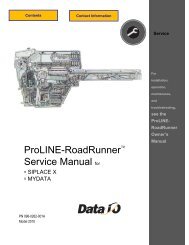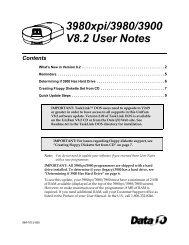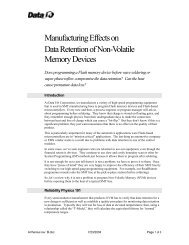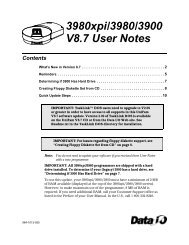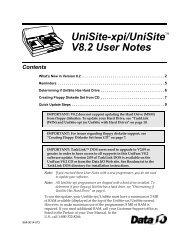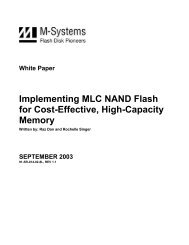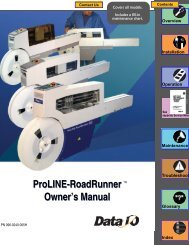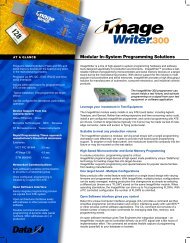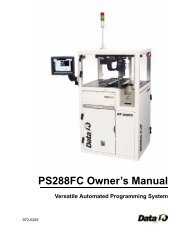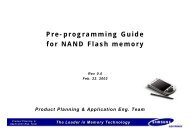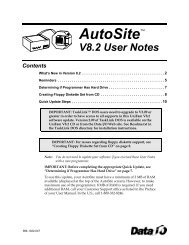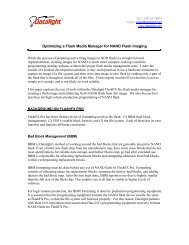3980xpi Users Manual - Data I/O Corporation
3980xpi Users Manual - Data I/O Corporation
3980xpi Users Manual - Data I/O Corporation
You also want an ePaper? Increase the reach of your titles
YUMPU automatically turns print PDFs into web optimized ePapers that Google loves.
Serial Output<br />
Commands<br />
The following parameters are available:<br />
� Source (R,D)<br />
Select the Source for the disk file data. Press SPACE to toggle between R<br />
(RAM) and D (disk).<br />
� Filename<br />
Specifies the name of the disk file from which the data are taken. This<br />
option appears only if Disk is selected as the Source. The filename<br />
parameter must follow standard DOS conventions (such as 27256.dat).<br />
� Output Filename<br />
Specifies the name of the disk file you want the formatted data sent to. The<br />
filename must follow standard DOS conventions (such as 27256.hex).<br />
� I/O Translation Format<br />
Specifies the translation format for the data. A complete listing of the<br />
formats is given in the Translation Formats chapter of this manual.<br />
� I/O Address Offset<br />
Enter the desired beginning address of the disk file. This field appears only<br />
if a non-JEDEC format has been selected. The programmer adds this value<br />
to the address of the data in memory (relative to the Memory Begin<br />
Address of 0) and outputs the sum as the I/O address. Entering FFFFFFFF<br />
sets the I/O Address Offset to 0.<br />
� Memory Begin Address<br />
Specifies the first address, in hex, from which the first byte of data is<br />
retrieved to write to the disk output file. If the source is RAM, it is a<br />
beginning RAM address. If the source is Disk, it is a beginning disk file<br />
address. The default address is 0. This field appears only if a non-JEDEC<br />
format has been selected.<br />
� User <strong>Data</strong> Size<br />
Specifies the hexadecimal size, in bytes, of the data block to be output,<br />
with translation, to the output file from the source. Enter the number of<br />
bytes to output. Entering zero sets User <strong>Data</strong> Size to the total number of<br />
hex bytes in the programmer User RAM, or the size of the source disk file if<br />
disk is used as source. This field appears only if a non-JEDEC format has<br />
been selected.<br />
More Commands/Transfer <strong>Data</strong>/Serial Output<br />
Use the Serial Output command to send data from the programmer to a serial<br />
device, such as a printer.<br />
Use this command to obtain a quick copy of programming or other devicerelated<br />
data. Serial Output does not do any data translating. If a logic device is<br />
selected, the fuse data are output by fuse number and the vectors are output<br />
by vector number. If a memory device is selected, the data are output by<br />
address in hex format.<br />
Output Memory <strong>Data</strong> to Serial Port<br />
More Commands/Transfer <strong>Data</strong>/Serial Output/Output Memory <strong>Data</strong><br />
When a memory device has been selected, the Serial Output command is<br />
output as a specified memory block to one of the programmer's serial ports.<br />
<strong>3980xpi</strong>/3980/3900/2900 User <strong>Manual</strong> 4-67




